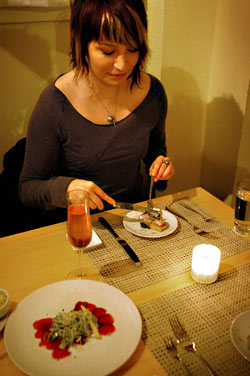Arriving after dead-earnest dishes like arugula salad with pears, walnuts, and ewe’s milk cheese and crispy pork belly with lentils, Tilth‘s mini duck burgers with fingerling potatoes may appear a wee bit precious.
But those nickel-sized chips, fried in duck fat, are a wee bit tasty. And when you bite into one of the 3-inch-round burgers, which are plump enough to stretch the definition of “mini,” the griddle-crisped whole-wheat roll first gives way to the twin riches of fig mustard and homemade ketchup. Then you breach the patty, pink-hearted and loosely molded, and it floods your mouth with juices.
A wee bit more than tasty.
There’s a serious playfulness that animates the dishes on chef Maria Hines’ menu, an eagerness to charm rather than dazzle. Though the restaurant is certified organic by Oregon Tilth (which means that 95 percent of the products the kitchen uses must be certified as well), Hines’ staff refrain from trumpeting their own virtues. Tilth may not be a perfect restaurant, but it’s a compellingly personal one.
Hines, of course, is the foremost of Seattle’s newest generation of celebrity chefs, whose tenure at Earth & Ocean earned her a spot on Food & Wine magazine’s 2005 “best new chefs” list. In early August, she took over a one-story Craftsman, on Wallingford’s main stretch, that used to house Mandalay Restaurant, made as many renovations as she could afford on a minimal budget, and opened Sept. 1.
Tilth’s format—every dish can be ordered small or large—is great. Those who prefer the pace and focus of a traditional meal aren’t forced to share their food, while restless diners like me can make the most of the dozen-item menu. The waiters recommend three plates per person, but five for two people is enough, especially if you need to placate your sugar demons afterward. Before you dive in, a tiny something (say, a small glass of cucumber soda) arrives from the kitchen; and when you’re done, the check comes with something extra, too (for instance, a spoonful of caramel). Staples in high-end restaurants but rare in a midpriced one, these amuses-bouches and mignardises feel like a gift from the chef.
Chef Hines’ food is simple but never straightforward. The sweet, elusive flavor of fennel flitted in and out of one of October’s best dishes: a salad of cannelini beans, chunks of smoked whitefish with paprika-rubbed edges, and poached mussels so creamy I could have sworn they were raw. A roasted fillet of Pete Knutson’s wild sockeye salmon (thanks, Pete) perched atop al dente chickpeas, brightened up with contrasting roasted-pepper and mint-cilantro purées. In November, a small slab of pork belly, fatty top layer crisped and lean bottom tender and rich, proved a stunning showcase of the kitchen’s technique.
Not all of the dishes were amazing enough to halt conversation. A grass-fed top sirloin steak, though properly medium rare and paired with flavorful duck-fat-poached fingerling potatoes, tasted both mushy and dry. Fall root vegetables, with a tomato-cumin sauce and a fried egg on top, were certainly pleasant but not the revelatory experience the waiter promised. Presented with Hines’ reimagined salade niçoise, we first snapped up a creamily deviled egg, then eagerly attacked the seared albacore tuna ornamented with roasted-tomato paste, black olives, and crisp-tender diced haricots verts in a snappy vinaigrette. The watery fried heirloom tomato at the base of the bowl, however, stymied us.
The farther the leap of imagination, the greater the payoff. A savory porcini crème brûlée with a burnt-sugar crust and vanilla foam sounded like a culinary thrill-seeking expedition, but the sweetness evaporated the moment the custard released the deepest porcini flavor I’ve ever tasted. And, applying the lessons she learned from her long partnership with renowned pastry chef Sue McCown, Hines crafts simple desserts with adventurous flavors. She plays with the boundary between savory and sweet—smoking (literally) dark Theo chocolate before folding it into the lightest of puddings, the centerpiece of a s’more reconstructed; or accompanying a mind-blowing sweet-corn crème brûlée with a mound of brown sugar tinged with ground-up bacon—but she never experiments at the diner’s expense.
The visual tension between home and restaurant works both for and against Tilth. The chef’s desire to work in relationship with her diners is mirrored in the sights and smells that flow between the open kitchen and what used to be the house’s living room. However, the combination of light tile floors and walls the color of whipped butter—designed to keep the closely spaced tables from feeling cramped—instead detracts from the restaurant’s cozy intimacy.
On my first visit, the waiter at our table provided the best service I’ve had since I moved to Seattle. He delivered all the markers of fine dining in the least showy manner, and he intuitively radiated welcome, that element of great service that training can never instill. Memories of that welcome smoothed over any frustration with my second server, who didn’t quite have it together. Things arrived willy-nilly and sometimes 30 minutes late. But she made up for her errors with a free dish, steered us away from one she didn’t think succeeded (frankness appreciated), and by the end of the meal, we were joking comfortably.
My friends and I spent $60 a person (including wine) for huge meals that, given Hines’ prime ingredients and reputation, she could have charged much more for. I worry that the buzz her career has accrued will lead diners to expect Tilth to be a bargain Herbfarm. In truth, Hines has created a wonderful neighborhood restaurant, the kind of place where you and your best friends can celebrate a bump in your paycheck or a rare night away from the kids. Tilth won’t transport you to another plane of existence—it’ll leave you content in the one you inhabit.






